Becoming a Learning Organization: Pickerington's Journey to Improve Learning Opportunities for All Children Fostered by a Culture of Collaborative Professionalism
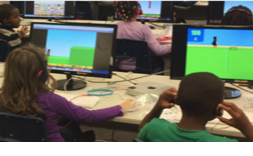
Pickerington Local Schools central office administrators credit their system-wide use of the Ohio Improvement Process (OIP) and Ohio Leadership Advisory Council (OLAC) resources for the district's increasing capacity to make the kind of informed instructional decisions needed to improve learning opportunities for every child.
"We've always been a relatively successful district if you're basing success on the report card, parent satisfaction, and students going further in their education or into the workforce, but we had a difficult time describing exactly how we achieved success," explained Sharon Caccimelio, Executive Director of Teaching and Learning. "We needed to identify those things in the system that we could do to assure that all students were achieving and succeeding," she said.
"We elected to use the OIP in 2013. You might ask why? Our district was growing and changing quickly. We had experienced academic success and were a district labeled 'Excellent with Distinction.' Yet, when asked how we were able to get results, no one could really provide an answer. We were doing what we had always done, the way we had always done it and it worked. We had no idea why, or if success would continue."
Sharon Caccimelio
Executive Director of Teaching & Learning
Pickerington City School District
The 15th largest district in the state, Pickerington serves close to 11,000 students in 15 school buildings. Pickerington's population has changed over the last five years, serving an increasing number of children identified as English learners – with 65 different languages spoken by the district's students – and an increasing number of students with special needs. "People move here to receive services," said Bob Blackburn, Assistant Superintendent of Student Services, for the district.
"We have a good reputation for providing a lot of support for students with disabilities and the community is open to folks coming into the community. We employ more people in the school district than in any other place in Pickerington. You would probably elect to live here because of the school district; there's not a lot of industry here," added Caccimelio.
Living the Plan
Pickerington's Plan for Progress, the district's strategic plan, is based on three pillars – Academic Excellence, Effective Operations, and Modern Facilities – all geared toward ensuring academic success for each child. Not unlike strategic plans developed by other districts in the state, the pillars address operational as well as instructional aspects of the school system. But how the plan is being used does differ. "The plan is driving all of the work that we're doing. We aspire to be the school district of choice, improving our community and society by opening doors and providing opportunities for every child every day," stated Caccimelio.
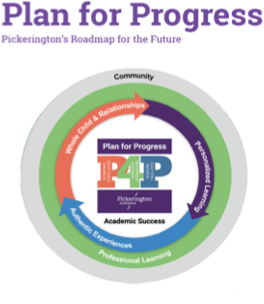
"The main goal of the academic pillar is the idea of moving our instruction and learning into the 21st century," said Brian Seymour, Pickerington's Director of Instructional Technology. Personalized learning, attending to the ‘whole child' and relationships (e.g., the relationship between the student and the teacher), and providing authentic experiences that pave the way for success are strategies for improving the quality of core instruction for all children in the district.
"We're obviously covering grade-level material, but we also look at gaps, where kids are struggling, and how to move them up. We also have kids that are way outperforming their grade level, so how can we continue to push them too," added Seymour.
"It's about making learning relevant and meeting students where they're at," commented Zack Howard, the district's Assistant Superintendent for Human Resources. Both Seymour and Howard began their careers in Pickerington as high school science teachers.
Professional learning, a fourth strategy, is wrapped around other plan components, conveying the need to position all educators in the district, regardless of assignment, to fulfill the promise of the Plan (i.e., high levels of learning for each students). "We're trying to get away from the idea of ‘professional development' and move into professional learning," explained Seymour. "We joke that nobody wants to wake up in the morning and say they want to be ‘developed,'" he added.
Learning Together
Pickerington's intended outcome in the area of professional learning is for educators to acquire, enhance, and refine the relevant knowledge, skills, practices, and mindsets necessary to create and support high levels of learning for each student (Plan for Progress: Pickerington's Roadmap for the Future, p. 14).
Central office leaders knew that realizing this outcome required the district to support educators at every level of the system to become more open to working collaboratively so they could learn from each other, learn together, and contribute to the collective instructional capacity of the district. "As a district, we shifted from ‘individual' to ‘team' and shared leadership, and our focus became learning together," explained Caccimelio. Unlike many districts who used the OIP in response to a perceived compliance mandate, Pickerington chose to use it to improve the district's capacity to prepare all children for success.
"The work of the TBTs, BLTs, and the DLT1 has been a game-changer for us. Our teachers are working collaboratively, they can use the data they're getting from assessments and other qualitative sources, and they can see that their work is indeed showing growth and change in student learning, which is really what it's all about," said Caccimelio. "OLAC materials helped us align our team structures (TBT, BLT, DLT) when we began using the OIP. Six years later, we are still learning and refining," she added.
Collaborative Professionalism
How teachers and other educators transform teaching and learning together to work with all students to develop fulfilling lives of meaning, purpose, and success. It is organized in an evidence-informed, but not data driven, way through rigorous planning, deep and sometimes demanding dialogue, candid but constructive feedback, and continuous collaborative inquiry. The joint work of collaborative professionalism is embedded in the culture and life of the school where educators actively care for and have solidarity with each other as fellow professionals as they pursue their challenging work together, and where they collaborate professionally in ways that are responsive to and inclusive of cultures of their students, themselves, the community, and the society. The collaborative aspect of professionalism refers to how members of their profession labor or work, rather than merely talk and reflect together.
Andy Hargreaves, PhD, December 5, 2019
"We've put a system into place that allowed us to make informed decisions for the district. BLT members are doing walkthroughs, instructional rounds, and providing feedback to teachers, not as an evaluative process, but to help focus the work on instructional practices," said Blackburn.
"The larger we've become, the harder it was to align our work. Having been in a building prior to the district office, sometimes you feel like you're in a silo. The OIP process has really helped us align vertically and horizontally across the district; it's been neat to see," reflected Howard. "We're looking for teachers that are willing to be collaborative and we host 150-160 student teachers or field placements each year. Our student teachers have a leg up because they've had a chance to be a part of a teacher-based team," he added.
"We always looked at student outcomes, but we didn't look at adult practice. And now, as a group, we're looking at adult practice; we're talking the same talk. And, we're talking about the fact that we know the number one inequity is what happens from classroom to classroom," said Caccimelio.
Pickerington's intentional efforts to build a culture of shared learning through collaborative professionalism (as described in the sidebar) is paying off. "Our performance index has increased over the past four years from a 75.4% to 80%, our overall progess has increased from a D to a B, and our overall gap closing has increased from 40.7% to 100%," stated Caccimelio.
Non-negotiables For Adult Professional Practice
During the 2018-19 school year, Pickerington central office personnel used OLAC resources and, in particular, a webinar by Brian McNulty titled Developing Non-negotiables with Your BLT2 as part of full-day professional learning for BLT members. Caccimelio describes the webinar as instrumental in supporting Pickerington educators to become more focused and intentional in their work. "The beauty of non-negotiable work is that it forces the group to look at their beliefs and values. The non-negotiables become what you hold all your decisions against and are also the ‘hills you are willing to die on,'" said Caccimelio.

Engaging in tough conversations to identify non-negotiables to guide the district's improvement work wasn't limited to BLTs. The DLT also "struggled through it, talked through it, and got through it," according to Caccimelio. "So if we say we believe all students can learn, what does that look like and how will we know? And what doesn't it look like?'"
DLT non-negotiables included such statements as "The DLT will identify and promote evidence-based improvement strategies;" "DLT practices emphasize continuous reflection, collaboration, and innovation;" "A primary DLT function is to eliminate institutional barriers to student success;" and "Collaboration is not an option." Identifying essential team beliefs at all levels led to a DLT reboot at the beginning of the 2019-2020 school year and a realization of the importance of district-level practices on the quality of instructional leadership. The DLT's primary focus is on (1) strengthening TBTs, (2) improving the effectiveness of interventions/supports, and (3) supporting principals.
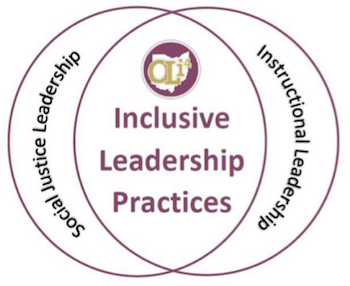
"Without district support, other schools in the district are unable to learn from an effective school," explained Caccimelio. "Sharing is really part of everyday life now, teachers are taking on leadership roles, and folks have more confidence in what they're able to do."
Inclusive Instructional Leadership
Pickerington's commitment to supporting principals as one of the core areas of work for the DLT involves participation in the Ohio Leadership for Inclusion, Implementation, and Instructional Improvement (OLi4).3 OLi4 supports cohorts of principals and district representatives in supporting teacher learning and in the effective use of OIP team structures by addressing six key practice domains: (1) visioning, (2) using data well, (3) sharing leadership, (4) reflecting on practice, (5) coaching teaching, and (6) using research and evidence to guide instruction. OLAC online learning resources, like the McNulty webinar on non-negotiables, are used support OLi4 cohort member learning.
"We have to build the capacity of everybody."
Brian Seymour
Director of Instructional Technology Pickerington City School District
Unique in its combined emphasis on social justice and instructional leadership, OLi4 is aligned with and contributes to the state's focus on the use of inclusive instructional and organizational leadership. Pickerington opted to have all 15 principals participate in OLi4 and, according to Howard, has tried to "embed and dovetail the OLi4 training principals are receiving with the Ohio Principal Evaluation System." "Our principals are visiting other principals' BLT meetings. We've got high school principals observing BLT meetings at the elementary level and vice versa," said Blackburn. "I'm hearing from all of our principals that it's the best thing they've ever been involved in," said Caccimelio.
Seymour summarizes: "We have to build the capacity of everybody. All of our principals serve on the DLT so we wanted to be able to continue the conversations begun through OLi4 and use the opportunity to impact the entire district. We've done a good job of being innovative and making change in pockets, but we really wanted this to be a systematic approach."
The ‘Big Picture' of Collaborative Professionalism: We're All In It Together
Ohio's state support teams (SSTs) support districts in using OIP-OLAC to address needs across multiple programmatic areas (e.g., early learning, literacy, special education, district and school improvement, etc.) – in order to improve equitable opportunities to learn, and higher levels of learning, for each child.
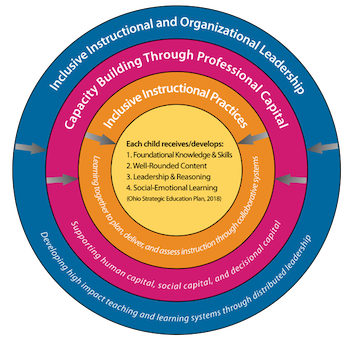
With Each Child, Our Future (Ohio's Strategic Plan for Education: 2019-2024)4, as the backdrop, the State Development Team (a group of state and regional leaders supported by the Columbus-based University of Cincinnati Systems Development & Improvement Center) identified three essential and inter-related areas of practice for guiding the work of the regional system: (1) inclusive instructional practices, (2) capacity building through professional capital, and (3) inclusive instructional and organizational leadership.
Toward Collaborative Professionalism
The work of the SSTs, regardless of the particular needs of the district, is to support that district in building its own capacity – its capital if you will – to become a learning organization able to engage all personnel in continuous improvement. Capacity building through professional capital involves getting better at using three types of capital to improve teaching and learning: (1) human capital (selection, induction, retention, evaluation functions designed to improve the quality and capabilities of personnel), (2) social capital (the quality and impact of interactions among people in a school district in relation to the district's mission), and (3) decisional capital (the capacity and expertise for making decisions) (Hargreaves & Fullan, 2012).
"It's our responsibility to come together on behalf of kids. The three elements of professional capital are tools to be used to get to collaborative professionalism. We don't 'do professional capital,' we use it."
Lynn McKahan
Director, State Support Team Region 1
"Since building capacity is the ultimate goal of the SST, the best way is to use practices embedded within all three areas of professional capital – human, social, and decisional," explained Lynn McKahan, Director of State Support Team Region 1 and team lead for the State Development Team workgroup on building capacity through professional capital.
"As SSTs, we need to support the integration of professional capital at the SST level, or how the SST uses practices in our work with districts, and at the district level – how the SST supports districts in understanding professional capital and how to incorporate it into their improvement efforts," added McKahan.
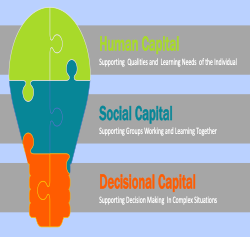
The OIP, supported by OLAC resources, provides the structure for fostering shared learning and decision making, as illustrated by the ongoing work of the Pickerington Local School District. According to McKahan, "OIP supports the entire process of inquiry; collaborative professionalism is at the very heart of OIP and supports districts in considering ‘how are we going to together grow our district, our schools, our kids, our families, our communities?'"
"We have a ways to go in supporting districts to create cultures of collaborative professionalism. It may be easier to look at the three aspects of professional capital, but we still need to get to the core belief system and non-negotiables in every district and building to say, ‘It's our responsibility to come together on behalf of kids.' The three elements of professional capital are tools to be used to get to collaborative professionalism. We don't ‘do professional capital,' we use it," she stated.
Developing cultures grounded in collaborative professionalism involves 10 tenets, according to Hargreaves and O'Conner (2018): collective autonomy, collective efficacy, collaborative inquiry, collective resonsibility, collective initiative, mutual dialoge, joint work, common meaning and purpose, collaborating with students, and big picture thinking for all. Hargreaves notes, "in collaborative professionalism, everyone gets the big picture. They see it, live it, and create it together."
"It's a journey. We've done a lot of work and we've come a long way, but there's still work to be done. One of the things that the process does is support us in understanding that if we're all in it together for the same purpose and we understand it, it doesn't matter who leaves or comes or goes," said Caccimelio.
Watch for the summer 2020 issue of Cornerstone Connections for a focus on inclusive instructional and organizational leadership!
References
Hargreaves, A., & Fullan, M. (2012). Professional capital: Transforming teaching in every school. New York, NY: Teachers College Press.
Hargreaves, A., & O'Connor, M. T. (2018). Collaborative professionalism: When teaching together means learning for all. Thousand Oaks, CA: Corwin.
Ohio Department of Education. (2019). Each child, our future. Ohio's strategic plan for education (2019-2024). Columbus, OH: Author. Retrievable from http://education.ohio.gov/getattachment/About/Ohios-Strategic-Plan-for-Education/Final-Strategic-Plan-Board-Approved.pdf.aspx?lang=en-US.
Plan for progress: Pickerington's roadmap for the future. (2019). Pickerington, OH: Pickerington Local School District. Retrievable from https://www.pickerington.k12.oh.us/wp content/uploads/2019/08/Pickerington-Plan-for-Progress-Report-v5A-2.pdf
For More Information
For more information about how Ohio’s SSTs are supporting districts to build capacity through professional capital, contact Lynn McKahan, Director, SST 1, at 800-346-8495 or 419-720-8999 (x 144), or via email at esclew_lm@sstr1.org.
For more information about Pickerington Local School District, contact Assistant Superintendent Zack Howard at 614.920.6105 or via email at zack_howard@plsd.us.
For more information about OLi4, contact Dr. Pamela VanHorn, project coordinator, UC Systems Development & Improvement Center, at 614.897.0020 or via email at: vanhorpm@ucmail.uc.edu.
For more information about the OLAC and OIP resources, contact Dr. Jim Gay, OLAC Co-director, at jimgay@basa-ohio.org; or Karel Oxley, OLAC Co-director, at Oxley@basa-ohio.org.